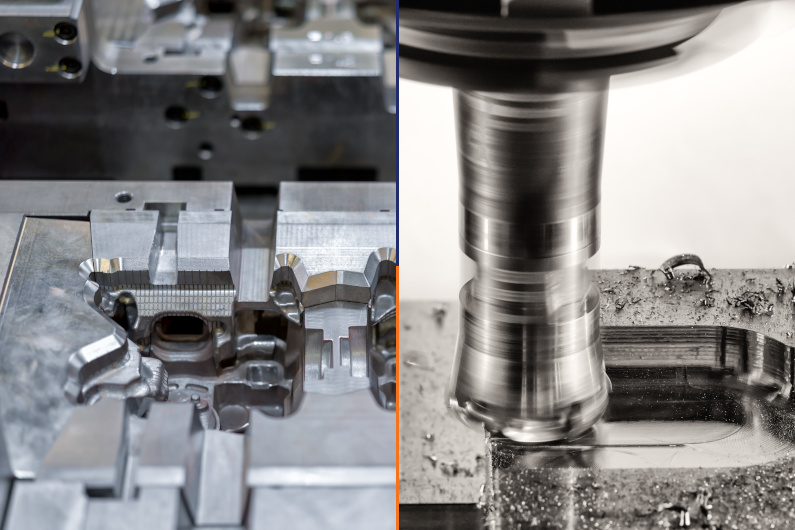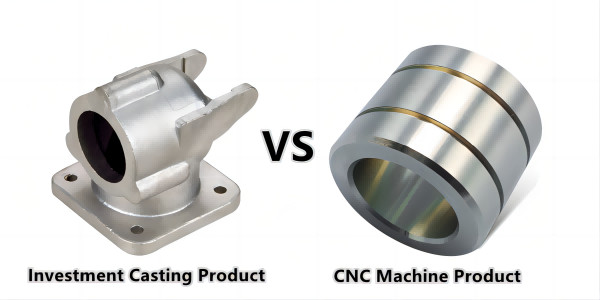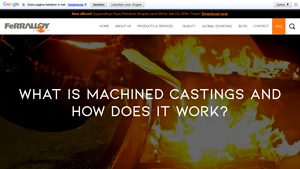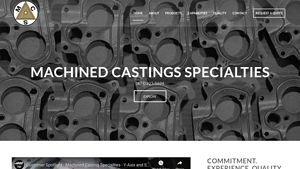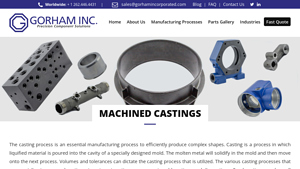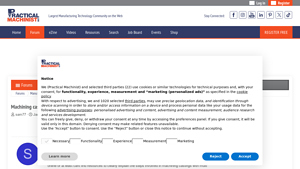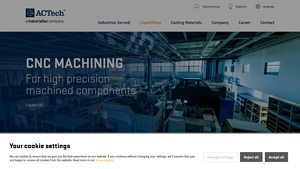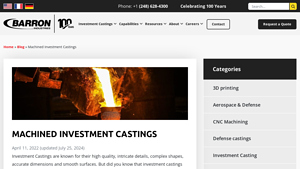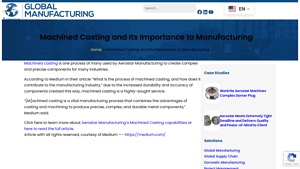Machined Casting Guide: Type, Cost, Top List…
Introduction: Navigating the Global Market for machined casting
In the ever-evolving landscape of global manufacturing, sourcing high-quality machined casting can pose significant challenges for B2B buyers. From ensuring precision and meeting tight tolerances to balancing cost and quality, the intricacies of machined casting demand a strategic approach. This comprehensive guide delves into the multifaceted world of machined casting, exploring various types, applications, and the essential processes involved in production. Whether you are looking to understand the nuances of investment, gravity, or sand casting, this resource will equip you with the knowledge to navigate the complexities of the market.
For international buyers, particularly those operating in Africa, South America, the Middle East, and Europe—regions known for their diverse manufacturing needs—making informed purchasing decisions is crucial. This guide not only outlines the key factors for vetting suppliers and assessing costs but also provides insights into the latest trends and technologies shaping the machined casting industry. By empowering you with actionable information, we aim to facilitate a smoother procurement process, enabling you to select the right partners and products that align with your operational goals. Embrace the opportunity to enhance your sourcing strategy and drive your business forward with confidence in the global machined casting market.
Understanding machined casting Types and Variations
| Type Name | Key Distinguishing Features | Primary B2B Applications | Brief Pros & Cons for Buyers |
|---|---|---|---|
| Investment Casting | High precision, intricate details, minimal machining | Aerospace, automotive, medical devices | Pros: Excellent surface finish, complex shapes. Cons: Higher upfront tooling costs. |
| Gravity Casting | Utilizes gravity to fill molds, suitable for larger parts | Heavy machinery, construction | Pros: Cost-effective for large volumes. Cons: Limited detail compared to investment casting. |
| Sand Casting | Versatile, uses sand molds, good for medium-sized parts | General manufacturing, prototyping | Pros: Low tooling costs, quick setup. Cons: Rougher surface finish, less precision. |
| Die Casting | High-volume production, high pressure to inject metal | Consumer products, electronics | Pros: Excellent dimensional accuracy, repeatability. Cons: Not cost-effective for small runs. |
| Grey Iron Casting | Strong, durable, good for complex geometries | Engine blocks, pipes, automotive components | Pros: Good wear resistance, excellent machinability. Cons: Heavier and less ductile than other materials. |
What Are the Characteristics of Investment Casting?
Investment casting is recognized for its ability to produce highly intricate parts with exceptional surface finishes. This method is particularly suitable for applications in aerospace and medical devices where precision is paramount. Buyers should consider the higher upfront costs associated with tooling and molds, which can be offset by the long-term benefits of reduced machining time and improved part quality. Investment casting is ideal for medium to large production runs where complex geometries are required.
How Does Gravity Casting Compare to Other Methods?
Gravity casting involves pouring molten metal into a mold using gravitational force, making it an efficient option for producing larger components. It is commonly used in heavy machinery and construction applications. While it is cost-effective for bulk production, buyers must note that gravity casting may not achieve the same level of detail as investment casting. However, its ability to produce robust parts at a lower cost makes it a favorable choice for specific industries.
What Are the Advantages of Sand Casting?
Sand casting is one of the most versatile casting methods, utilizing sand molds that can be easily shaped and reused. This method is particularly advantageous for general manufacturing and prototyping, as it allows for low tooling costs and quick setup times. However, the trade-off is a rougher surface finish and lower precision compared to other casting types. Buyers should weigh the benefits of cost savings against the potential need for additional machining to achieve desired specifications.
What Makes Die Casting Ideal for Mass Production?
Die casting is characterized by its ability to produce high volumes of parts with excellent dimensional accuracy through high-pressure injection of molten metal. This method is widely used in the production of consumer products and electronic components. While die casting is highly efficient for large production runs, it may not be the best choice for small quantities due to the higher costs associated with mold creation. Buyers should focus on the long-term production needs when considering die casting.
Why Choose Grey Iron Casting for Durability?
Grey iron casting is known for its strength and durability, making it an excellent choice for applications requiring complex geometries, such as engine blocks and pipes. This casting type offers good wear resistance and machinability, making it suitable for various automotive components. However, buyers should consider that grey iron is heavier and less ductile than other materials, which may impact design choices. Understanding the specific requirements of the application will help in making an informed decision regarding grey iron casting.
Key Industrial Applications of machined casting
| Industry/Sector | Specific Application of machined casting | Value/Benefit for the Business | Key Sourcing Considerations for this Application |
|---|---|---|---|
| Aerospace | Engine Components and Structural Parts | High precision and lightweight parts enhance fuel efficiency and performance. | Compliance with stringent safety standards and certification requirements. |
| Automotive | Transmission Housings and Engine Blocks | Improved durability and performance through tailored designs. | Material compatibility and ability to produce high-volume orders. |
| Oil and Gas | Pump Casings and Valve Bodies | Enhanced operational reliability in harsh environments, reducing downtime. | Ability to handle large, complex geometries and corrosion-resistant materials. |
| Industrial Machinery | Gearboxes and Housing Components | Increased efficiency and reduced maintenance costs through precise manufacturing. | Need for rapid prototyping and quick turnaround times for production. |
| Medical Devices | Surgical Instruments and Implantable Components | High precision and biocompatibility ensure safety and efficacy in medical applications. | Certification for medical-grade materials and adherence to quality standards. |
How is Machined Casting Used in Aerospace Applications?
In the aerospace industry, machined casting is pivotal for producing engine components and structural parts that require both lightweight and high strength. These components must meet rigorous safety and performance standards while also optimizing fuel efficiency. Buyers in this sector should prioritize suppliers who can provide certified products that adhere to strict aerospace regulations, ensuring both reliability and safety in flight.
What Role Does Machined Casting Play in the Automotive Sector?
Machined castings are integral to the automotive industry, particularly for manufacturing transmission housings and engine blocks. The ability to create complex geometries allows for optimized designs that enhance the durability and performance of vehicles. B2B buyers should consider sourcing from manufacturers who can produce high-volume orders with material compatibility to meet the specific requirements of automotive applications, ensuring longevity and efficiency.
Why is Machined Casting Critical for Oil and Gas?
In the oil and gas sector, machined castings are essential for producing pump casings and valve bodies that operate reliably under extreme conditions. These components must be robust and capable of withstanding corrosive environments, thereby reducing maintenance and downtime. Buyers should seek suppliers with expertise in creating large, complex geometries and materials that offer corrosion resistance, ensuring their operations remain efficient and cost-effective.
How Does Machined Casting Benefit Industrial Machinery?
Machined castings are widely used in the production of gearboxes and housing components within industrial machinery. The precision of these castings results in increased operational efficiency and reduced maintenance costs over time. For international buyers, the ability to rapidly prototype and achieve quick turnaround times is crucial, making it essential to partner with manufacturers who can meet these demands effectively.
What is the Importance of Machined Casting in Medical Devices?
In the medical device industry, machined castings are vital for creating surgical instruments and implantable components that require high precision and biocompatibility. The safety and efficacy of these products directly impact patient outcomes, making it critical for buyers to source from suppliers who adhere to stringent quality standards and can provide medical-grade materials. This ensures that the devices meet both regulatory requirements and patient safety expectations.
3 Common User Pain Points for ‘machined casting’ & Their Solutions
Scenario 1: Inconsistent Quality Across Machined Castings
The Problem: A common issue faced by B2B buyers in the machined casting sector is inconsistent quality in the final products. This inconsistency can stem from variations in the casting process, tooling wear, or differences in machining settings. For instance, a manufacturer in Brazil may receive castings that do not meet specified tolerances, resulting in rejected parts and costly delays. This can severely impact production schedules and client relationships, especially in industries where precision is critical, such as aerospace or automotive.
The Solution: To mitigate quality issues, buyers should prioritize partnering with suppliers who implement robust quality assurance processes. Request detailed documentation on the supplier’s quality control measures, including certifications like ISO 9001. Additionally, engaging in pre-production meetings can help establish clear specifications and tolerances. It’s also beneficial to conduct initial sample runs or prototypes before committing to large orders. This approach allows for adjustments and ensures that the final products align with quality standards, ultimately fostering a more reliable supply chain.
Scenario 2: Long Lead Times Affecting Production Schedules
The Problem: Buyers often experience extended lead times for machined castings, which can disrupt their production schedules. Factors contributing to these delays can include inadequate supplier capacity, unexpected machinery downtime, or lengthy tooling setups. For example, a company in Saudi Arabia might find that their supplier cannot meet the tight deadlines required for a new product launch, risking significant financial implications and loss of competitive advantage.
The Solution: To address lead time challenges, buyers should conduct thorough due diligence when selecting suppliers. Look for manufacturers with a proven track record of timely deliveries and sufficient production capacity. Establishing long-term partnerships can also provide more predictable lead times. Implementing advanced planning techniques, such as Just-In-Time (JIT) inventory systems, can help synchronize production schedules with supplier timelines. Regular communication and updates on production status can further ensure that both parties remain aligned and can quickly adapt to any potential delays.
Scenario 3: Difficulty in Achieving Complex Geometries
The Problem: Achieving complex geometries in machined castings can pose a significant challenge for many buyers. Parts requiring intricate shapes, fine details, or tight tolerances may not be easily produced using standard casting methods. For instance, a manufacturer in Europe may struggle to produce a component with unique internal channels or overhangs, leading to compromised functionality and increased costs due to additional machining or rework.
The Solution: To overcome difficulties with complex geometries, it’s crucial to engage with suppliers who specialize in advanced machining techniques, such as CNC machining or investment casting. When specifying your requirements, provide comprehensive 3D models and detailed drawings that highlight the intricacies of your design. Collaborating with engineers from the supplier’s team during the design phase can also lead to innovative solutions that optimize the manufacturing process. Furthermore, consider investing in rapid prototyping services to test designs before full production, ensuring that complex features can be achieved without compromising quality or functionality.
Strategic Material Selection Guide for machined casting
What Are the Key Materials for Machined Casting?
When selecting materials for machined casting, it’s essential to consider the unique properties and performance characteristics that will impact the final product. Below, we analyze four common materials used in machined casting, focusing on their key properties, advantages and disadvantages, application impacts, and considerations for international B2B buyers.
How Does Aluminum Influence Machined Casting Applications?
Aluminum is a popular choice for machined castings due to its lightweight nature and excellent corrosion resistance. Its key properties include a melting point of around 660°C and a density of approximately 2.7 g/cm³, making it suitable for applications that require good strength-to-weight ratios.
Pros: Aluminum offers high durability, is easy to machine, and has good thermal conductivity. It is particularly well-suited for automotive and aerospace applications where weight savings are critical.
Cons: The main limitations include relatively high costs compared to some ferrous materials and lower strength at elevated temperatures. Additionally, aluminum’s susceptibility to wear can be a concern in high-friction applications.
Impact on Application: Aluminum is compatible with various media, including water and certain chemicals, making it versatile for different environments.
Considerations for International Buyers: Buyers from regions such as Europe and the Middle East should ensure compliance with standards like ASTM B108 or DIN 1725, which govern aluminum casting specifications.
What Role Does Steel Play in Machined Casting?
Steel, particularly carbon and alloy steels, is widely used in machined casting due to its strength and versatility. Key properties include a melting point of around 1370-1510°C and high tensile strength, which can exceed 600 MPa depending on the alloy composition.
Pros: Steel castings are known for their durability and ability to withstand high pressures and temperatures, making them ideal for heavy machinery and structural applications.
Cons: The primary drawbacks include higher manufacturing complexity and costs, particularly for high-alloy steels. Additionally, steel can be prone to corrosion unless treated or alloyed properly.
Impact on Application: Steel is compatible with various media, including oil and gas, which makes it suitable for industries like energy and construction.
Considerations for International Buyers: Compliance with standards such as ASTM A216 or JIS G5502 is crucial, especially for buyers in South America and Africa, where local regulations may dictate specific material properties.
How Does Ductile Iron Enhance Machined Casting Performance?
Ductile iron, also known as nodular cast iron, is increasingly favored for its excellent mechanical properties and machinability. It has a melting point of about 1150-1300°C and offers high tensile strength and ductility.
Pros: Ductile iron provides good wear resistance and shock absorption, making it suitable for automotive components and heavy machinery.
Cons: While generally cost-effective, ductile iron can be more expensive than traditional cast iron. Its brittleness at low temperatures can also limit its application in colder climates.
Impact on Application: Ductile iron is compatible with various media, including water and certain oils, making it versatile for different industrial applications.
Considerations for International Buyers: Buyers should ensure compliance with standards like ASTM A536, which governs ductile iron specifications, particularly in Europe and the Middle East.
What Advantages Does Bronze Offer in Machined Casting?
Bronze, an alloy primarily made of copper and tin, is known for its corrosion resistance and wear properties. It has a melting point of around 950-1050°C and exhibits excellent machinability.
Pros: Bronze is highly durable, resistant to corrosion, and provides good thermal and electrical conductivity, making it suitable for marine applications and electrical components.
Cons: The main limitations include higher costs compared to aluminum and steel, and it may not be as strong as some steel alloys.
Impact on Application: Bronze is particularly compatible with seawater and various chemicals, making it ideal for marine and chemical processing applications.
Considerations for International Buyers: Compliance with standards such as ASTM B150 is essential for buyers from regions like Africa and South America, where specific regulations may apply.
Summary of Material Selection for Machined Casting
| Material | Typical Use Case for machined casting | Key Advantage | Key Disadvantage/Limitation | Relative Cost (Low/Med/High) |
|---|---|---|---|---|
| Aluminum | Aerospace and automotive components | Lightweight and corrosion-resistant | Higher cost compared to ferrous metals | Medium |
| Steel | Heavy machinery and structural parts | High strength and durability | Higher manufacturing complexity | High |
| Ductile Iron | Automotive components and machinery | Excellent wear resistance | Brittle at low temperatures | Medium |
| Bronze | Marine and electrical applications | Corrosion-resistant | Higher cost and lower strength | High |
This strategic material selection guide provides B2B buyers with essential insights into the various materials available for machined casting, enabling informed decision-making tailored to their specific application needs.
In-depth Look: Manufacturing Processes and Quality Assurance for machined casting
What Are the Key Stages in the Manufacturing Process of Machined Casting?
Machined casting is a sophisticated process that combines casting and machining techniques to produce high-quality metal parts. This hybrid approach offers the advantages of both methods, allowing for intricate designs and tight tolerances. The manufacturing process can be broken down into several key stages:
1. Material Preparation: How Is the Right Material Selected and Processed?
The first step involves selecting the appropriate material based on the specific requirements of the component. Common materials for machined castings include aluminum, bronze, and iron alloys. Once the material is chosen, it undergoes preparation, which may involve melting, alloying, and pouring into molds.
Heat treatment may also be applied to enhance the mechanical properties of the metal. This stage is crucial, as the quality of the raw material significantly influences the final product’s performance.
2. Forming: What Techniques Are Used to Shape the Castings?
The forming stage is where the casting takes place. Techniques vary based on the desired characteristics of the final product:
- Sand Casting: A versatile method suitable for complex shapes, sand casting involves creating a mold from sand and pouring molten metal into it.
- Investment Casting: This method allows for high precision and intricate geometries, making it ideal for components requiring tight tolerances and fine details.
- Die Casting: Utilized for high-volume production, die casting involves forcing molten metal into a mold under high pressure, resulting in consistent dimensions and surface finishes.
After the metal has cooled and solidified, the casting is removed from the mold, and any excess material is trimmed.
3. Assembly: How Are Multiple Components Integrated?
In cases where the machined casting comprises multiple parts, the assembly stage comes into play. This may involve welding, bolting, or other fastening methods to ensure that the components fit together precisely. Quality assurance checks are critical during this stage to ensure that the assembled parts meet the required specifications.
4. Finishing: What Processes Ensure the Final Product Meets Quality Standards?
The finishing stage involves various processes designed to enhance the surface quality and dimensional accuracy of the casting. Common finishing techniques include:
- Machining: This is often the final step, where CNC machines are used to achieve precise dimensions and tolerances. This step is particularly important for parts with complex geometries that cannot be achieved through casting alone.
- Surface Treatments: Processes such as grinding, polishing, and coating may be applied to improve the surface finish and corrosion resistance of the component.
What Quality Assurance Measures Are Essential for Machined Casting?
Quality assurance (QA) is a critical component of the manufacturing process for machined casting, ensuring that the final products meet both international and industry-specific standards. Here are the main QA measures that B2B buyers should consider:
Relevant International Standards: Which Certifications Should Buyers Look For?
For global B2B transactions, compliance with international standards is crucial. The ISO 9001 standard for quality management systems is one of the most recognized certifications. It ensures that manufacturers maintain consistent quality and continuous improvement in their processes.
Additionally, specific industries may require adherence to standards such as:
- CE Marking: Common in Europe, indicating that products meet health, safety, and environmental protection standards.
- API Certification: Relevant for components used in the petroleum and natural gas industry, ensuring they meet specific performance criteria.
QC Checkpoints: What Are the Key Stages of Quality Control?
Quality control in machined casting typically involves several checkpoints:
-
Incoming Quality Control (IQC): This initial checkpoint assesses the quality of raw materials before production begins. Suppliers must provide certification and test reports for the materials used.
-
In-Process Quality Control (IPQC): During manufacturing, inspections are conducted to ensure that the processes are being followed correctly and that the parts are meeting specified tolerances.
-
Final Quality Control (FQC): After production, a final inspection is performed to verify that the finished product meets all specifications and standards. This may include dimensional checks, surface finish assessments, and functional tests.
How Can B2B Buyers Verify Supplier Quality Control?
For international B2B buyers, verifying a supplier’s quality control processes is essential to mitigate risks and ensure product reliability. Here are actionable strategies:
Conducting Audits: What Should Buyers Look For?
Buyers should consider conducting on-site audits to evaluate the manufacturing facilities, quality control processes, and adherence to relevant standards. During an audit, buyers can assess:
- The quality management system in place.
- Documentation practices for quality checks.
- Employee training and competency in quality assurance.
Requesting Reports: How Can Documentation Support Quality Assurance?
Buyers should request detailed quality assurance reports from suppliers, including:
- Certifications of compliance with international standards.
- Results from IQC, IPQC, and FQC assessments.
- Records of any non-conformance incidents and corrective actions taken.
Utilizing Third-Party Inspection: What Are the Benefits?
Engaging third-party inspection services can provide an unbiased assessment of the supplier’s quality control processes. These organizations can conduct random inspections and provide certification that the products meet specified standards, adding an additional layer of assurance for buyers.
What Are the Quality Control Nuances for International B2B Buyers?
For B2B buyers from regions such as Africa, South America, the Middle East, and Europe, understanding the nuances of quality control in international trade is crucial:
-
Cultural Differences: Different regions may have varying approaches to quality assurance. Buyers should be aware of these differences when negotiating contracts and setting expectations.
-
Regulatory Compliance: Each region may have specific regulatory requirements for imported goods. Buyers must ensure that their suppliers are compliant with local laws and standards.
-
Language Barriers: Communication issues can arise during quality assurance discussions. Buyers should consider working with suppliers who can provide documentation and support in the buyer’s preferred language.
By understanding the manufacturing processes and quality assurance measures involved in machined casting, B2B buyers can make informed decisions, ensuring they receive high-quality products that meet their specific needs.
Practical Sourcing Guide: A Step-by-Step Checklist for ‘machined casting’
To assist international B2B buyers in sourcing machined castings effectively, this guide offers a structured checklist. By following these steps, you can ensure that your procurement process is thorough and that you select the best suppliers to meet your specific requirements.
Step 1: Define Your Technical Specifications
Begin by clearly outlining the technical specifications of the machined castings you need. This includes material types, dimensions, tolerances, surface finishes, and any specific geometrical features. Having detailed specifications helps suppliers understand your needs and can prevent costly misunderstandings later in the process.
Step 2: Research Potential Suppliers
Conduct thorough research to identify potential suppliers who specialize in machined castings. Look for companies with experience in your industry and check their capabilities, including the types of machining and casting methods they employ. This step is crucial as it sets the foundation for finding a supplier that can meet your specific requirements.
Step 3: Evaluate Supplier Certifications
Before engaging in business, verify that suppliers hold relevant certifications, such as ISO 9001 or industry-specific standards. Certifications indicate a commitment to quality and adherence to international manufacturing standards. This step helps mitigate risks associated with quality control and ensures that the supplier is equipped to deliver high-quality machined castings.
Step 4: Request Samples and Prototypes
Ask for samples or prototypes of the machined castings to assess the quality and precision of the supplier’s work. This allows you to evaluate their machining capabilities and ensures that their products meet your specifications. Pay close attention to details such as surface finish, dimensional accuracy, and material integrity.
Step 5: Assess Production Capabilities
Inquire about the supplier’s production capacity and lead times. Understanding their ability to scale production to meet your demands is essential, especially if you anticipate needing large volumes. Additionally, discuss their production processes to ensure they can handle the complexities of your specific casting needs.
Step 6: Review Quality Control Processes
Investigate the quality control measures that potential suppliers have in place. This includes the testing methods they use and their approach to defect management. A robust quality assurance process is vital for ensuring that the machined castings you receive meet your specifications consistently.
Step 7: Negotiate Terms and Establish a Partnership
Once you’ve identified a suitable supplier, negotiate terms including pricing, payment conditions, and delivery schedules. Establishing a strong partnership based on clear communication and mutual understanding can lead to better service and collaboration in future projects. Ensure that both parties are aligned on expectations to foster a successful long-term relationship.
By following this checklist, you can navigate the sourcing process for machined castings more efficiently, ensuring that you find a reliable supplier that meets your technical and operational needs.
Comprehensive Cost and Pricing Analysis for machined casting Sourcing
What Are the Key Cost Components in Machined Casting Sourcing?
Understanding the cost structure of machined casting is essential for B2B buyers to make informed decisions. The primary cost components include:
-
Materials: The choice of metal significantly impacts cost. Common materials include aluminum, iron, and steel, each with varying price points based on market conditions and alloy specifications. High-performance alloys may offer superior properties but can increase overall costs.
-
Labor: Labor costs encompass the wages for skilled machinists and operators involved in both casting and machining processes. Regions with lower labor costs, such as parts of Africa and South America, may offer competitive pricing but could also result in variations in quality.
-
Manufacturing Overhead: This includes costs associated with facility maintenance, utilities, equipment depreciation, and administrative expenses. Efficient operations and economies of scale can help reduce overhead costs, ultimately benefiting the buyer.
-
Tooling: Tooling costs can be substantial, particularly for custom parts. Initial investments in molds or dies for casting and specific tools for machining can vary widely. Buyers should consider the amortization of these costs over expected production volumes.
-
Quality Control (QC): Ensuring product quality involves inspection and testing, which can add to the cost. Suppliers with rigorous QC processes may charge more, but they also provide assurance of reliability and performance.
-
Logistics: Shipping and handling costs can significantly affect the total price, especially for international buyers. Factors such as distance, mode of transport, and customs duties should be accounted for in the overall cost analysis.
-
Margin: Suppliers will include a profit margin in their pricing, which can vary based on competition, market demand, and the complexity of the parts. Understanding the supplier’s margin can provide insight into pricing flexibility during negotiations.
What Influences the Pricing of Machined Castings?
Several factors can influence the pricing of machined castings:
-
Volume and Minimum Order Quantity (MOQ): Larger orders typically reduce the per-unit cost due to economies of scale. Buyers should negotiate MOQs that align with their production needs to optimize costs.
-
Specifications and Customization: Custom parts with complex geometries or specific performance requirements will generally incur higher costs. Clear communication of specifications can help in obtaining accurate quotes and avoiding unexpected charges.
-
Material Selection: The type and quality of materials chosen directly affect pricing. High-performance materials may offer benefits but also come at a premium.
-
Quality and Certifications: Suppliers that adhere to international quality standards (e.g., ISO certifications) may charge higher prices. However, these certifications can be crucial for industries where safety and reliability are paramount.
-
Supplier Factors: The reputation, experience, and location of the supplier can influence pricing. Established suppliers with a track record of quality may command higher prices, but they often provide better service and reliability.
-
Incoterms: Understanding the Incoterms used in transactions is vital for calculating total costs. Different terms can affect who bears the costs and risks of shipping, impacting the overall price.
How Can Buyers Negotiate Better Prices for Machined Castings?
B2B buyers can employ several strategies to negotiate better pricing on machined castings:
-
Leverage Volume Discounts: Consolidating orders or committing to long-term contracts can provide leverage for negotiating lower prices per unit.
-
Assess Total Cost of Ownership (TCO): Consider not just the upfront cost but the TCO, including maintenance, logistics, and potential downtime. Choosing a slightly higher-priced supplier with superior quality may save money in the long run.
-
Explore Alternative Suppliers: Conducting market research to identify multiple suppliers can provide competitive quotes and strengthen negotiating power.
-
Understand Pricing Nuances: Familiarize yourself with the local market conditions, currency fluctuations, and geopolitical factors that might affect pricing, especially for international transactions.
-
Build Strong Relationships: Establishing a good rapport with suppliers can lead to better pricing and terms. Suppliers are more likely to offer discounts to reliable, long-term clients.
What Should International Buyers Consider When Sourcing Machined Castings?
For international buyers from regions like Africa, South America, the Middle East, and Europe, several additional considerations apply:
-
Import Duties and Taxes: Be aware of any import tariffs or taxes that may apply when bringing goods into your country, as these can significantly affect total costs.
-
Cultural and Communication Barriers: Understanding cultural differences in business practices and communication styles can help facilitate smoother negotiations and transactions.
-
Logistical Challenges: International shipping can present challenges, including longer lead times and potential delays. Planning for these factors is essential to maintain production schedules.
-
Currency Risks: Fluctuations in currency exchange rates can impact pricing. Consider negotiating contracts in stable currencies or using financial instruments to hedge against these risks.
Disclaimer for Indicative Prices
Pricing for machined castings can vary widely based on a multitude of factors. The information provided serves as a guideline and may not reflect actual market prices. Buyers are encouraged to conduct thorough research and obtain quotes from multiple suppliers to ensure competitive pricing tailored to their specific needs.
Alternatives Analysis: Comparing machined casting With Other Solutions
Understanding Alternatives to Machined Casting: A Comparative Analysis
In the quest for optimal manufacturing solutions, businesses often find themselves evaluating various methods to produce high-quality components. Machined casting, a hybrid approach combining both casting and machining processes, offers unique advantages. However, it’s essential to consider alternative methods that may better suit specific operational needs. This section compares machined casting against two viable alternatives: traditional casting and CNC machining, providing insights into their respective strengths and weaknesses.
| Comparison Aspect | Machined Casting | Traditional Casting | CNC Machining |
|---|---|---|---|
| Performance | High precision and complex geometries | Good for large volumes, less precise | Exceptional detail and tight tolerances |
| Cost | Moderate, cost-effective for small to medium runs | Cost-effective in bulk production | Higher costs for low volumes due to setup |
| Ease of Implementation | Requires specialized equipment and expertise | Established processes, easier for large runs | Requires skilled operators and software setup |
| Maintenance | Moderate; depends on equipment used | Generally low, but mold maintenance needed | High; requires regular machine upkeep |
| Best Use Case | Custom parts with specific requirements | Mass production of identical parts | Prototyping and complex designs |
In-Depth Analysis of Alternatives
What Are the Benefits and Drawbacks of Traditional Casting?
Traditional casting methods, such as sand casting or investment casting, excel in producing large quantities of identical components. The primary advantage lies in their cost-effectiveness for mass production, where the initial investment in molds can be offset by the low cost per unit in larger runs. However, traditional casting may lack the precision required for complex geometries and tight tolerances, leading to additional machining processes later on. This can result in higher overall production times and costs if not managed efficiently.
How Does CNC Machining Stand Out as an Alternative?
CNC machining is renowned for its ability to create intricate parts with exceptional detail and precision. This method is ideal for projects requiring quick turnarounds and prototyping, allowing for rapid iterations of designs. The flexibility of CNC machining also means a wide range of materials can be used. However, the costs can escalate for small production runs due to setup time and waste generation. Additionally, CNC machines may have size limitations that restrict the dimensions of parts that can be produced.
Making the Right Choice: How to Select the Best Solution for Your Needs
When considering the best manufacturing solution, B2B buyers must evaluate their specific project requirements, including volume, complexity, and budget constraints. Machined casting provides a balanced approach for those needing precise, custom components in moderate quantities. On the other hand, traditional casting is best for high-volume, uniform parts, while CNC machining excels in flexibility and precision for smaller runs or prototypes. Ultimately, the decision should align with the strategic goals of the business and the technical demands of the project at hand.
Essential Technical Properties and Trade Terminology for machined casting
What Are the Key Technical Properties of Machined Castings?
Understanding the essential technical properties of machined castings is vital for B2B buyers to make informed decisions. Here are some critical specifications to consider:
1. Material Grade
The material grade refers to the specific type of metal used in the casting process, which can significantly influence the strength, durability, and machinability of the final product. Common materials include aluminum, steel, and iron, each offering distinct properties suitable for various applications. For instance, aluminum is lightweight and corrosion-resistant, making it ideal for automotive parts, while steel provides high tensile strength, suitable for structural applications. Selecting the appropriate material grade is crucial for meeting performance requirements and ensuring the longevity of the components.
2. Tolerance
Tolerance defines the allowable deviation from specified dimensions in the machined casting. It is essential for ensuring that parts fit together correctly and function as intended. Tight tolerances are particularly important in industries like aerospace and automotive, where precision is critical for safety and performance. Establishing the required tolerances upfront helps prevent costly reworks and ensures that the final products meet the stringent standards of quality and reliability.
3. Surface Finish
Surface finish refers to the texture and smoothness of the final machined part. It can affect not only the aesthetic appeal but also the functional characteristics, such as friction and wear resistance. Different applications may require varying surface finishes; for example, a smoother finish is necessary for parts that will be in motion, while a rougher finish may be acceptable for static components. Understanding the surface finish requirements is essential for meeting both performance and aesthetic criteria.
4. Dimensional Stability
Dimensional stability refers to a material’s ability to maintain its dimensions over time and under varying environmental conditions. This property is crucial for machined castings used in precision applications, where any change in dimensions can lead to performance issues. Factors such as temperature fluctuations and humidity can affect dimensional stability. Selecting materials and processes that enhance stability can mitigate risks associated with manufacturing defects and ensure long-term performance.
5. Weight
Weight is a critical consideration in industries where the overall mass of components impacts performance, such as aerospace and automotive sectors. Lighter materials can lead to improved fuel efficiency and easier handling, whereas heavier materials might provide better durability and strength. Understanding the weight implications of different material grades and casting methods allows buyers to optimize their designs for functionality and efficiency.
What Are Common Trade Terms in Machined Casting?
In addition to technical properties, familiarizing oneself with industry terminology is essential for effective communication and negotiation in B2B transactions. Here are some common terms used in the machined casting industry:
1. OEM (Original Equipment Manufacturer)
An OEM refers to a company that produces parts or equipment that may be marketed by another manufacturer. In the context of machined castings, understanding whether a supplier is an OEM can help buyers assess the quality and reliability of the components they are sourcing.
2. MOQ (Minimum Order Quantity)
MOQ is the minimum number of units that a supplier is willing to sell in a single order. This term is crucial for buyers to understand, as it can impact inventory management and cash flow. Knowing the MOQ helps buyers plan their purchasing strategy to avoid overstocking or stockouts.
3. RFQ (Request for Quotation)
An RFQ is a formal request sent by a buyer to suppliers to obtain pricing and other relevant information for specific products. This document is vital for comparing offers and negotiating terms. A well-prepared RFQ can streamline the procurement process and ensure that buyers receive competitive pricing.
4. Incoterms (International Commercial Terms)
Incoterms are a set of predefined international trade terms that outline the responsibilities of buyers and sellers in shipping and freight arrangements. Familiarity with Incoterms helps B2B buyers understand who is responsible for costs and risks at different stages of the shipping process, ensuring smoother international transactions.
5. Lead Time
Lead time refers to the time it takes from placing an order to receiving the finished product. Understanding lead times is critical for project planning and inventory management. Buyers should consider lead times in relation to their production schedules to avoid delays in their supply chains.
By grasping these essential properties and trade terms, B2B buyers can enhance their procurement strategies, ensuring that they source the right machined castings for their specific needs while navigating the complexities of international trade efficiently.
Navigating Market Dynamics and Sourcing Trends in the machined casting Sector
What Are the Current Market Dynamics and Key Trends in the Machined Casting Sector?
The machined casting sector is experiencing robust growth driven by global demand for high-precision components across various industries, including automotive, aerospace, and industrial machinery. As international B2B buyers increasingly seek customized solutions, the integration of advanced technologies such as CNC machining and additive manufacturing is becoming essential. This trend allows manufacturers to produce intricate geometries and achieve tighter tolerances that traditional casting methods may not provide. Furthermore, the rising adoption of Industry 4.0 practices, including automation and real-time data analytics, is streamlining production processes and enhancing supply chain efficiencies.
In regions like Africa, South America, the Middle East, and Europe, there is a notable shift towards localized sourcing to mitigate risks associated with global supply chain disruptions. For instance, buyers in Saudi Arabia and Brazil are increasingly prioritizing suppliers that can offer quick turnaround times and flexibility in production volumes. The emphasis on shorter supply chains also reflects a growing awareness of the environmental impact of logistics, prompting companies to evaluate their sourcing strategies critically.
Emerging trends also highlight the importance of technological innovation in the machined casting sector. The use of artificial intelligence (AI) for predictive maintenance and quality control is gaining traction, enabling manufacturers to minimize downtime and ensure consistent product quality. As sustainability becomes a key concern for B2B buyers, the demand for eco-friendly manufacturing processes and materials is on the rise, influencing sourcing decisions and supplier evaluations.
How Can Sustainability and Ethical Sourcing Be Integrated in Machined Casting?
Sustainability is increasingly becoming a cornerstone of B2B sourcing strategies in the machined casting sector. The environmental impact of traditional manufacturing processes, including high energy consumption and waste generation, has prompted buyers to seek suppliers that prioritize sustainable practices. Companies are now focusing on reducing their carbon footprint by opting for energy-efficient production methods and sourcing materials that align with green certifications.
Ethical sourcing is equally important in today’s global marketplace. B2B buyers are urged to assess their suppliers not just on cost and quality, but also on their commitment to fair labor practices and responsible sourcing of raw materials. Certifications such as ISO 14001 for environmental management and ethical sourcing standards play a vital role in supplier selection. By partnering with suppliers who uphold these principles, companies can enhance their brand reputation while contributing to a more sustainable industry.
Additionally, there is a growing trend towards utilizing recycled materials in the production of machined castings. This practice not only reduces waste but also lowers production costs, making it an attractive option for cost-conscious buyers. As more manufacturers adopt circular economy principles, the demand for machined castings produced from sustainable sources is expected to rise, influencing future sourcing strategies.
What Is the Historical Evolution of Machined Casting and Its Significance for B2B Buyers?
The history of machined casting is a testament to the evolution of manufacturing techniques that have shaped the modern industrial landscape. Initially, casting methods date back over 5,000 years, with ancient civilizations utilizing simple molds to create metal components. As industrialization progressed, the advent of machining technologies in the 19th century marked a significant turning point. This allowed for greater precision and the ability to produce complex geometries that casting alone could not achieve.
Today, the integration of machining and casting methods has created a hybrid approach that maximizes the strengths of both processes. For B2B buyers, understanding this evolution is crucial, as it highlights the importance of selecting suppliers capable of leveraging these advanced techniques to meet specific project requirements. The ability to source components that are not only functional but also tailored to unique specifications is a key advantage in today’s competitive marketplace.
In summary, the machined casting sector is undergoing transformative changes driven by technological advancements, sustainability imperatives, and evolving market dynamics. By staying informed about these trends, international B2B buyers can make strategic sourcing decisions that enhance their operational efficiency and align with their corporate values.
Frequently Asked Questions (FAQs) for B2B Buyers of machined casting
-
How do I choose the right machined casting supplier for my needs?
When selecting a machined casting supplier, consider their experience, production capabilities, and industry reputation. Request samples to assess quality and precision. It’s essential to evaluate their technical expertise, particularly in the specific materials and geometries you require. Additionally, inquire about their certifications, such as ISO compliance, and their ability to meet your delivery timelines. Reviews and testimonials from previous clients can provide insight into their reliability and customer service. -
What are the key benefits of using machined castings over traditional casting methods?
Machined castings offer enhanced precision and the ability to create complex geometries that traditional casting methods may struggle to achieve. The machining process allows for tighter tolerances and finer surface finishes, which can significantly reduce the need for post-production work. Additionally, machined castings can be customized to meet specific requirements, making them ideal for unique applications in various industries. This combination of precision and customization often leads to better overall performance in the final application. -
What is the typical minimum order quantity (MOQ) for machined castings?
Minimum order quantities for machined castings can vary widely based on the supplier, the complexity of the part, and the materials used. Generally, MOQs can range from a few units for prototypes to hundreds or thousands for mass production. It’s advisable to discuss your specific needs with potential suppliers to understand their MOQ policies and how they align with your project requirements. Establishing a clear communication channel can help in negotiating terms that fit your production goals. -
What payment terms should I expect when sourcing machined castings internationally?
Payment terms for international transactions in machined castings typically include options such as advance payment, letters of credit, or net 30/60 days upon receipt of goods. Many suppliers may require a deposit upfront, especially for custom or high-value orders. It’s crucial to negotiate terms that protect both parties and ensure timely delivery. Consider using secure payment methods and consult with your financial institution to understand the implications of currency exchange rates and transaction fees. -
How can I ensure quality assurance (QA) in my machined casting orders?
To ensure quality assurance in machined casting orders, establish clear specifications and tolerances in your purchase agreement. Request detailed documentation, including material certifications and inspection reports. Many suppliers offer in-house QA processes, such as dimensional checks and surface finish assessments, so inquire about their procedures. Conducting periodic audits or requesting third-party inspections can further safeguard quality, particularly for high-stakes projects in industries like aerospace and automotive. -
What are the common logistics considerations when importing machined castings?
Logistics for importing machined castings involve understanding shipping methods, customs regulations, and potential duties or tariffs. Ensure that your supplier is familiar with international shipping protocols and can provide necessary documentation, such as bills of lading and customs declarations. Consider using freight forwarders or logistics partners who specialize in international trade to streamline the process. Additionally, factor in lead times for production and shipping to avoid disruptions in your supply chain. -
What customization options are available for machined castings?
Machined castings can be customized in various ways, including material selection, dimensions, surface finishes, and additional features like threading or holes. Discuss your specific requirements with potential suppliers to understand the extent of customization they can offer. Some suppliers may provide design assistance or prototyping services to refine your specifications before production. This collaborative approach can help ensure that the final product aligns with your operational needs and performance expectations. -
What challenges should I be aware of when sourcing machined castings from overseas?
Sourcing machined castings internationally can present challenges such as language barriers, cultural differences, and varying standards of quality. Time zone differences may complicate communication and project timelines. Additionally, understanding local regulations and compliance requirements is crucial to avoid legal issues. To mitigate these risks, conduct thorough due diligence on potential suppliers, establish clear communication protocols, and consider visiting facilities if feasible to build trust and ensure alignment on quality expectations.
Important Disclaimer & Terms of Use
⚠️ Important Disclaimer
The information provided in this guide, including content regarding manufacturers, technical specifications, and market analysis, is for informational and educational purposes only. It does not constitute professional procurement advice, financial advice, or legal advice.
While we have made every effort to ensure the accuracy and timeliness of the information, we are not responsible for any errors, omissions, or outdated information. Market conditions, company details, and technical standards are subject to change.
B2B buyers must conduct their own independent and thorough due diligence before making any purchasing decisions. This includes contacting suppliers directly, verifying certifications, requesting samples, and seeking professional consultation. The risk of relying on any information in this guide is borne solely by the reader.
Top 7 Machined Casting Manufacturers & Suppliers List
1. Ferralloy – Machined Castings
Domain: ferralloy.com
Registered: 1998 (27 years)
Introduction: Machined castings are customized metal cast parts that undergo machining to meet specific requirements. The machining process can take various forms, including cutting (for precise geometry), non-traditional methods (using chemical and electrical energy), and abrasive techniques (like sand casting or grinding). Ferralloy Inc. guarantees the quality of their machined castings and offers consultatio…
2. Machined Castings Specialties – CNC Machining & Automation Services
Domain: machinedcastingsspecialties.com
Registered: 2018 (7 years)
Introduction: Machined Castings Specialties offers affordable machining, casting, engineering, and automation services. Key capabilities include CNC Machining, Flexible CNC with Automation, High-Speed CNC Probing, Auto-Compensation, Automatic Gaging, Tool Compensation, Eddy Current Inspection, and Seal Assembly. The company utilizes advanced technology, including the latest version of AutoCad inventor, to ensur…
3. Gorham Incorporated – Machined Castings
Domain: gorhamincorporated.com
Registered: 2000 (25 years)
Introduction: Machined Castings are produced through various casting processes including sand castings, investment castings, permanent mold castings, and die castings. Sand castings are suitable for lower volume runs and large components. Investment castings offer high accuracy for thin-walled parts with complex geometries and superior surface finishes. Permanent mold castings are ideal for materials with lower…
4. Practical Machinist – Key Processes in Machining Castings
Domain: practicalmachinist.com
Registered: 2000 (25 years)
Introduction: Machining castings involves several key processes and considerations: 1. **Setup**: Castings are typically clamped to the machine table, and initial alignment is often done by eye. 2. **Machining Operations**: The process usually starts with roughing passes to remove excess material, followed by finishing passes. 3. **Equipment**: Large 5-axis gantry mills are preferred for large castings to minim…
5. Rapid Castings – CNC Machining Services
Domain: rapidcastings.com
Registered: 2002 (23 years)
Introduction: Machining of castings at ACTech includes CNC machining for high precision components, offering services for various industries such as automotive, aerospace, maritime, and more. Key capabilities include:
– In-house machining department with years of experience.
– Premium CNC machining for parts of all sizes and geometries.
– Extensive tool inventory with over 15,000 tool components and 900 unwindi…
6. Barron Industries – Machined Investment Castings
Domain: barron-industries.com
Registered: 2008 (17 years)
Introduction: Machined Investment Castings are high-quality, intricate, and complex components known for their accurate dimensions and smooth surfaces. They typically require less machining than conventional castings. Standard investment casting tolerances are +/-0.010” for the first inch and +/-0.005” for each succeeding inch. The investment casting process involves creating a mold from a pattern made of wax o…
7. Aerostar Manufacturing – Machined Casting Solutions
Domain: aerostarmfg.com
Registered: 2003 (22 years)
Introduction: Machined casting is a manufacturing process used by Aerostar Manufacturing to create complex and precise components for various industries. It combines the advantages of casting and machining to produce durable metal components. Aerostar specializes in global sourcing and manufacturing for sectors including automotive, heavy truck, defense, and aerospace. Their capabilities include CNC production …
Strategic Sourcing Conclusion and Outlook for machined casting
As the demand for precision and customization in manufacturing continues to rise, the role of strategic sourcing in machined casting becomes increasingly crucial for international B2B buyers. Understanding the distinct advantages of machined castings—such as their ability to achieve complex geometries, tight tolerances, and superior surface finishes—allows companies in Africa, South America, the Middle East, and Europe to optimize their production processes while minimizing costs.
Strategic sourcing not only enhances supply chain efficiency but also fosters partnerships with manufacturers that can deliver high-quality, tailored solutions. By leveraging both casting and machining methods, businesses can effectively balance production volumes and prototype needs, ensuring they remain competitive in a dynamic market.
Looking ahead, the integration of advanced technologies like CNC machining and AI will further revolutionize the machined casting landscape, offering unprecedented opportunities for innovation. Now is the time for international B2B buyers to engage with experienced suppliers who can provide insight and expertise in these evolving processes. By doing so, you position your organization for sustained growth and success in the global marketplace.
